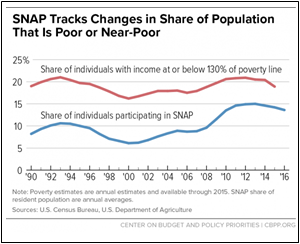SNAP Participation Doesn’t Snap Back – That’s By Design
The Supplemental Nutrition Assistance Program (SNAP) safeguards families from food insecurity, ensuring that millions of families, including nearly 20 million children, do not go hungry in America each year. The program successfully responds to economic changes, with participation and expenditures rising during times of economic crisis, before falling during the ensuing recovery. In fact, the number of people on SNAP is on the decline, dropping from a high of over 47 million in 2013 to 44 million persons today.
Participation in SNAP does not immediately fall during an economic recovery. That is by design. While the overall economy might be recovering, not every family regains its economic footing at the same rate. Thus, it is not surprising that while overall the number of SNAP recipients has declined in recent years, it remains above pre-recession levels. Congressional Republicans cite these ongoing higher participation numbers to justify their long-held desire to drastically cut SNAP by converting it into a shrinking and less effective block grant, ultimately causing deep harm to the economic security of families struggling to get by. However, comparing pre- and post-recession participation numbers oversimplifies the economic conditions families face today and ignores critical demographic factors that explain current SNAP participation levels. It takes time to undo the damage of the recession and for families to return to a sustainable path without the need for benefits that provide a basic standard of living.
SNAP Works as Intended

SNAP responds immediately and effectively to changing economic conditions. During an economic downturn, households already eligible but not yet participating, or those who find themselves newly eligible for SNAP, can immediately enroll and receive benefits. This provides a critical safety net for people by ensuring they can feed themselves and their families as they face uncertain economic conditions. Then, as the economy improves, individuals and households roll off the program as they find work. However, declines in participation lag behind economic recoveries because even as people return to work, it takes time to return to their pre-recession level of earnings. By protecting individuals from food insecurity while they are working their way back to economic stability, SNAP helps ensure that families do not go hungry.
Comparing Participation to Pre-Recession Levels Ignores the Reality Facing Families Today
Even as the economy recovers, wage growth remains stagnant for workers on the lower rungs of the earnings ladder, while wealth continues to accumulate at the top. In calendar year 2007, there were 54 million people below 130 percent of the federal poverty level. In 2016 there were 58 million individuals below that level. This means that more households and individuals could be eligible for SNAP today compared to pre-recession levels. Not only did the recession result in more individuals becoming eligible for SNAP, but participation rates also jumped from 69 percent in 2007 to 83 percent in 2015.
Although the official poverty rate fell in 2016 to near the level it was in 2007 before the recession, population growth means that nearly 3.4 million more Americans are still in poverty compared to 2007. Many low-wage jobs fail to provide enough income for families to meet their basic standards of living. Maintaining a full-time minimum-wage job often leaves families below the poverty line, and therefore eligible for benefits like SNAP. Until there is more widely shared prosperity, including rising wages for those at the low end of the income scale, there will be a need for government to provide income security to working families who, despite their best efforts, do not earn a living wage.
Finally, gains made during the economic recovery would not significantly decrease SNAP participation among recipients not expected to work, including disabled adults (9 percent or nearly 4 million recipients in 2016) and the elderly (12 percent or more than 5 million recipients). And, while overall SNAP participation is declining, the one group seeing growth is seniors – a trend that will continue as the population ages.
Conclusion
As designed, SNAP responds to changing economic conditions, allowing families facing unforeseen economic hardship the security of knowing they can feed themselves and their children. Participation in the program remains higher today because of the economic reality facing lower-income families, as well as the population growth nationwide. While we expect to continue seeing declines in SNAP participation, the number of people served by SNAP may never return to the same pre-recession number. With a growing population, stagnant wages, and millions of Americans who work but still fall below the eligibility threshold, SNAP serves a population in need. That population is simply larger than it was before the recession, and cuts to SNAP would only hurt millions of people who are already struggling to get by.